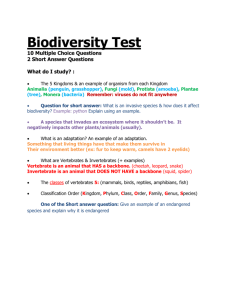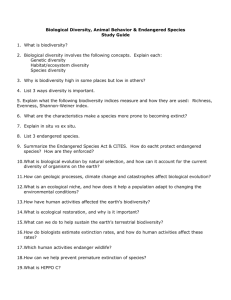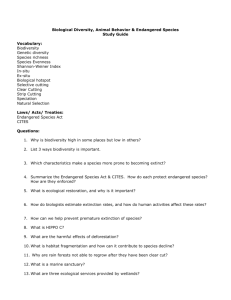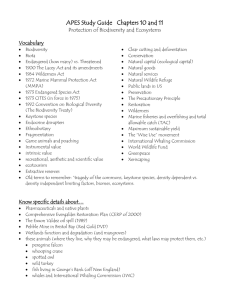C H A P T E R 1 1 Biodiversity: Preserving Species 223 Learning
advertisement
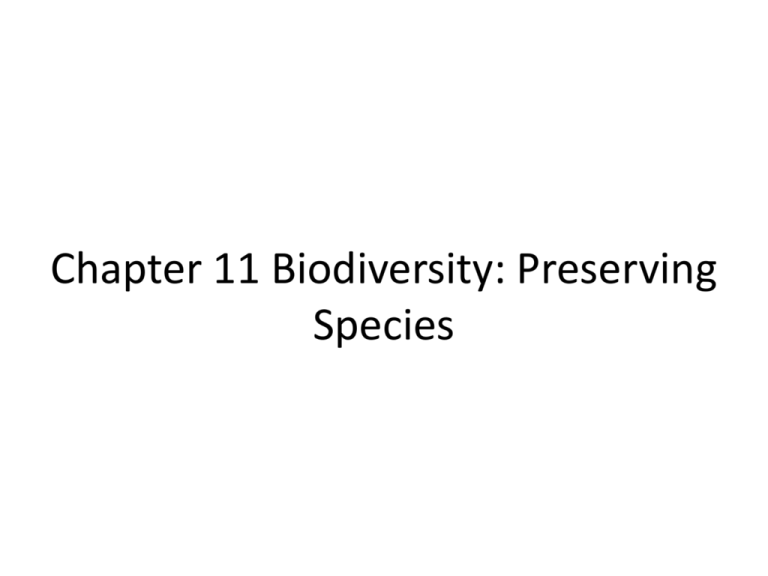
Chapter 11 Biodiversity: Preserving Species 11.1 Biodiversity And The Species Concept • What is biodiversity? • What are species? – Genetically Similar Organisms Capable of Interbreeding Among Themselves – With Some Exceptions (Dogs, Wolves and Coyotes) – The Red Wolf (Canis Rufus) – Is it a Species? – Really Problematic at the Microscopic Level Classification Level Humans Dogs Kingdom Animalia Animalia Phylum Chordata Chordata Class Mammalia Mammalia Order Primata Carnivora Family Hominidae Canidae Genus Homo Canis Species sapiens familiaris Below Species Level • Subspecies – Panthera tigris tigris (Bengal Tiger) – Panthera tigris sumatrae (Sumatran Tiger) – Panthera tigris altaica (Siberian Tiger) • Race: Distinctive Variety of Species or Subspecies – Considered to Have Little Biological Meaning for Humans • Variety, Strain, Breed, etc. Molecular Techniques Are Revolutionizing Taxonomy • “Five Kingdom” System – Animalia – Plantae – Protista (Single-Celled) – Fungi – Bacteria (No Cell Nucleus) • Levels Above Kingdom – Bacteria are More Different Than Everything Else Levels Above Kingdom • What’s Bigger than a Kingdom? – Empire? No: Domain or Superkingdom • Eukarya: Everything With a Cell Nucleus – Every Organism You Can See • • • • Monera (Bacteria) Archaea (Many are Extremophiles) Monera and Archaea outweigh and Outumber Us We Need Molecular Biology to Detect These Differences Molecular Techniques Are Revolutionizing Taxonomy • The Case of Crocodiles • Ancient Egyptians Knew of Two Kinds of Crocodiles – Big, Dangerous Deep Water Crocodiles – Smaller, Near-Shore, “Less Dangerous” • Genetic Studies Show They Were Right • The Less Dangerous Ones Are More Closely Related to American Crocodiles How many species are there? • • • • • • • 62,000 Vertebrates (Half are Fish) A Million Insects (23,000 Fossil) 250,000 Other Invertebrates 300,000 Plants (280,000 Broad-Leaf Plants) Estimated 7-100 Million Unknown 700 Dinosaurs (9,000 Living Reptiles) 70,000 Fossil Mollusks Hot spots have exceptionally high biodiversity • • • • • • • • New Zealand Horn of Africa Southeast Asia-Indonesia Pacific Islands Caribbean Islands Mediterranean Caucasus California 11.2 How Do We Benefit From Biodiversity? • All of our food comes from other organisms • Living organisms provide us with many useful drugs and medicines • Biodiversity provides ecological services • Biodiversity also brings us many aesthetic and cultural benefits 11.3 What Threatens Biodiversity? • • • • Extinction is a natural process We are accelerating extinction rates Invasive Species Island ecosystems are particularly susceptible to invasive species • What Can You Do? Don’t Buy Endangered Species Products 11.4 Endangered Species Management • Hunting and fishing laws have been effective • Legislation is key to biodiversity protection • Recovery plans rebuild populations of endangered species – Predators Help Restore Biodiversity in Yellowstone • Private land is vital in endangered species protection • Endangered species protection is controversial • Large-scale, regional planning is needed • International wildlife treaties are important 11.5 Captive Breeding And Species Survival Plans • Zoos can help preserve wildlife • We need to save rare species in the wild – “Charismatic’ Species • Reconstituting Extinct Organisms? – Critics: Focus on Preserving Present
